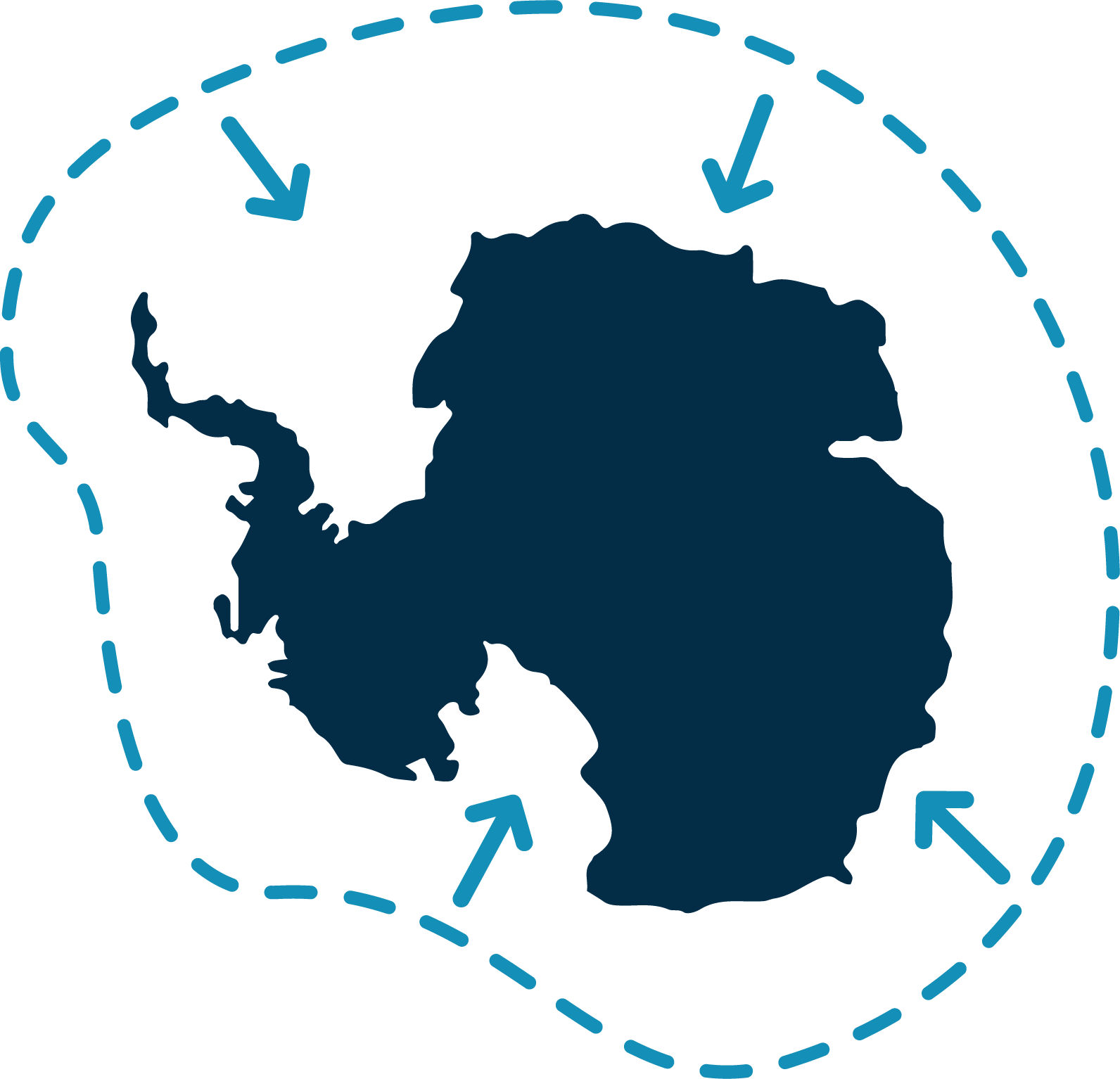
What are the drivers for summer and winter reductions of Antarctic sea ice?


How do biogeochemistry and ecosystems link to atmosphere, ocean and cryosphere (frozen) systems?

Science and Implentation Plan
- Space and time distribution of key physical properties including sea-ice and snow thickness, as well as snow and sea-ice structure, chemistry, and thermal properties, upper ocean characteristics, floe size, and lead distribution.
- Essential elements for climate models such as forcing and validation fields.
- Factors influencing biological processes i.e., data to understand how the sea-ice system affects associated marine life.
- What are the broad-scale time-varying distributions of sea-ice and snow-cover thickness, sea-ice composition and other physical characteristics in the Antarctic sea-ice zone.
- What are the dominant processes of sea-ice formation, modification, decay and transport that influence and determine sea-ice thickness, composition and distribution?
- How do snow characteristics and processes affect the sea-ice zone, including via variations in the snow microstructure, snow-ice conversions and changes in the spatial distribution and seasonal accumulation of Antarctic snow?
- What is the role of polynyas and glacial-ice processes, especially in the coastal fringe, in determining total sea-ice production, heat, salt and biogeochemical fluxes, and water mass modification?
- What are the processes that control the sea ice-ocean interactions at the sea-ice edge, and their seasonal changes?
- Data recovery - ongoing and especially important following the reduced data acquisitions due to COVID19 measures.
- Extension of the ASPeCt sea-ice and snow climatologies.
- Adoption of Best Practices for sea-ice and snow observations. Observations and measurements need to follow agreed standard practices and derived data products need to include required metadata and measures such as data uncertainty.
- Bring data together to build comprehensive merged data sets to analyse the current change in the sea ice-snow system, to validate remotely sensed data products, to inform model parameterisations, for input into data assimilation schemes, and to initialize or verify model simulations. ASPeCt drives open data and encourages open science.
- Establish long-term observatories including repeat transects through the sea-ice zone including fast ice, moored observatories and lagrangian drifter networks, to attain a wholesome, cross-disciplinary systems approach.
- Conduct process studies, including drift stations or multiple vessel deployments, to understand the drivers of the spatio-temporal variability of sea-ice and snow properties.
- Engage strongly in multi-national or global iniatives, such as Antarctica InSync [hyperlink: https://www.antarctica-insync.
org/ ] (2027/2028) and the 5th International Polar Year [https://iasc.info/cooperations/international- ] (2032/33).polar-year-2032-33 (Antarctica InSync (Antarctica International Science & Infrastructure for Synchronous Observation) addresses the need for large, collaborative and synchronous observation, to generate data and knowledge to understand, protect and sustainably manage the Southern Ocean and Antarctica including ocean, land and atmosphere. It is a UNESCO Ocean Decade [https://oceandecade.org/] Action and endorsed by SCAR.)(5th International Polar Year (IPY) 2032/33: The interim Secretariat for the IPY planning process is being provided by the Secretariats of the International Arctic Science Committee [https://iasc.info/] (IASC) and the Scientific Committee on Antarctic Research [https://scar.org/] (SCAR).) - ASPeCt draws on early-career and high-degree candidate researchers, and supports science-education programmes.
- ASPeCt strives for a diverse, equitable and inclusive (DEI) research approach.
- ASPeCt provides an outlet for effective science communication and public engagement, including promoting science to society.
Data sets
Data protocols
Key publications
Arndt, S., N. Maaß, L. Rossmann, and M. Nicolaus, From snow accumulation to snow depth distributions by quantifying meteoric ice fractions in the Weddell Sea, The Cryosphere, 18, 2001–2015, doi:10.5194/tc-18-
Fierro-Arcos, D., S. Corney, A. Meyer, H. Hayashida, A.E. Kiss, and P. Heil, Analysis of ecologically relevant sea ice and ocean variables for the Southern Ocean using a high-resolution model to inform ecosystem studies, Progress in Oceanography, 215, 103049, doi:10.1016/j.pocean.2023.103049, 2023.
Fraser, A.D., P. Wongpan, et al., Antarctic Landfast Sea Ice: A review of its physical, biogeochemstry and ecological, Reviews of Geophysics, doi:10.1029/2022rg000770, 2023.
Isaacs, F.E., J.A. Renwick, A.N. Mackintosh, R. Dadic, ENSO modulates summer and autumn sea-ice variability around Dronning May Land, Antarctica, Journal of Geophysical Research, doi:10.1029/2020JD033140, 2021.
Heil, P., C. Stevens, W.S. Lee, C. Eayers, H.C. Shin, S.P. Alexander, and W. Rack, Bridging the gap for ice-ocean-atmosphere-ecosystem processes: Integrated Observing System for the Ross Sea to the far East Antarctic Region, Frontiers Marine Sc., doi:10.3389/fmars.2023.
Hobbs, W., P. Spence, A. Meyer, S. Schroeter, A.D. Fraser, P. Reid, T.R. Tian, Z. Wang. G. Linger, E.W. Doddridge and P.W. Boyd, Observational evidence for a regime shift in summer Antarctic sea ice. Journal of Climate, 37, 2263–2275, doi:10.1175/JCLI-D-23-0479.1, 2024.
Roach, L.A., J. Dörr, C.R. Holmes, F. Massonnet, E.W. Blockley, D. Notz, et al., Antarctic sea ice area in CMIP6. Geophysical Research Letters, 47, doi:10.1029/2019GL086729, 2020.
Saenz, B., D. McKee, S. Doney, D. Martinson, and S. Stammerjohn, Influence of seasonally varying sea-ice concentration and subsurface ocean heat on sea-ice thickness and sea-ice seasonality for a ‘warm-shelf’ region in Antarctica, Journal of Glaciology, 1-17, doi:10.1017/jog.2023.36, 2023.
Moore, K.A., P.H. Smythe, and C.W. Hui et al., Remote sensing using remotely piloted aircraft systems in Antarctica, Frontiers in Remote Sensing, 62, 102 – 136, 2017.
Ohshima, K. I., Y. Fukamachi, M. Ito, K. Nakata, D. Simizu, K. Ono, D. Nomura, G. Hashida, T. Tamura, Dominant frazil ice production in the Cape Darnley polynya leading to Antarctic Bottom Water formation. Science Advances, 8, eadc9174, doi:10.1126/sciadv.adc9174, 2022.
Pitt, J.P.A., L.G. Bennetts, M.H. Meylan, R.A. Massom and A. Toffoli, Model predictions of wave overwash extent into the marginal ice zone, Journal of Geophysical Research, doi:10.1029/2022JC018707, 2022.
Porter-Smith, R., J. McKinlay, A.D. Fraser, and R.A. Massom, Coastal complexity of the Antarctic continent, Earth System Science Data, doi:10.5194/essd-13-3103-2021, 2021.
Tersigni, I., A. Alberello, G. Messori, M. Vichi, M. Onorato, and A. Toffoli, High-resolution thermal imaging in the Antarctic marginal ice zone: Skin temperature heterogeneity and effects on heat fluxes. Earth and Space Science, 10, doi:10.1029/2023EA003078, 2023.
Zhao, J., B. Cheng, T. Vihma, P. Lu, H. Han, Q. Shu, and F. Qiao, Internal melting of Antarctic landfast sea ice resulting in gap layer formation. Environ. Res. Lett. 17, 074012, doi:10.1088/1748-9326/
For a full list of publications see Open Research and Contributor ID (ORCID) for member's of the ASPeCt community.
